Christina Lioma
The Quest for Reliable Metrics of Responsible AI
Oct 29, 2025Abstract:The development of Artificial Intelligence (AI), including AI in Science (AIS), should be done following the principles of responsible AI. Progress in responsible AI is often quantified through evaluation metrics, yet there has been less work on assessing the robustness and reliability of the metrics themselves. We reflect on prior work that examines the robustness of fairness metrics for recommender systems as a type of AI application and summarise their key takeaways into a set of non-exhaustive guidelines for developing reliable metrics of responsible AI. Our guidelines apply to a broad spectrum of AI applications, including AIS.
As easy as PIE: understanding when pruning causes language models to disagree
Mar 27, 2025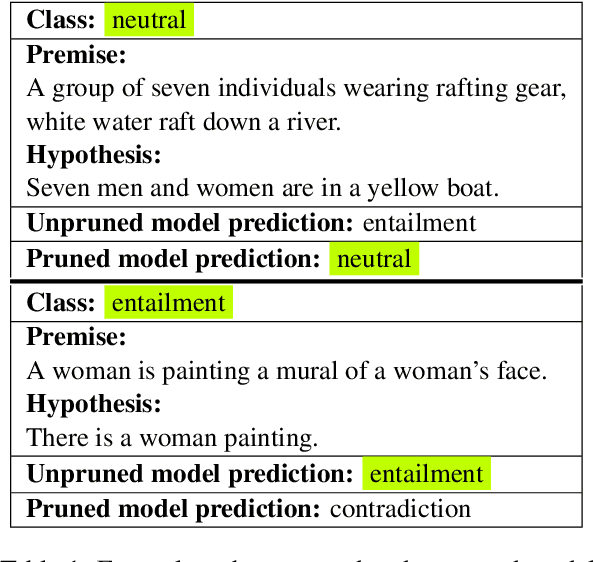
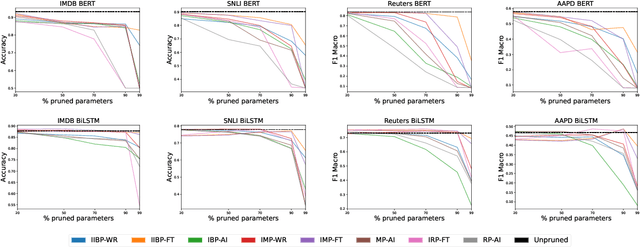


Abstract:Language Model (LM) pruning compresses the model by removing weights, nodes, or other parts of its architecture. Typically, pruning focuses on the resulting efficiency gains at the cost of effectiveness. However, when looking at how individual data points are affected by pruning, it turns out that a particular subset of data points always bears most of the brunt (in terms of reduced accuracy) when pruning, but this effect goes unnoticed when reporting the mean accuracy of all data points. These data points are called PIEs and have been studied in image processing, but not in NLP. In a study of various NLP datasets, pruning methods, and levels of compression, we find that PIEs impact inference quality considerably, regardless of class frequency, and that BERT is more prone to this than BiLSTM. We also find that PIEs contain a high amount of data points that have the largest influence on how well the model generalises to unseen data. This means that when pruning, with seemingly moderate loss to accuracy across all data points, we in fact hurt tremendously those data points that matter the most. We trace what makes PIEs both hard and impactful to inference to their overall longer and more semantically complex text. These findings are novel and contribute to understanding how LMs are affected by pruning. The code is available at: https://github.com/pietrotrope/AsEasyAsPIE
Joint Evaluation of Fairness and Relevance in Recommender Systems with Pareto Frontier
Feb 17, 2025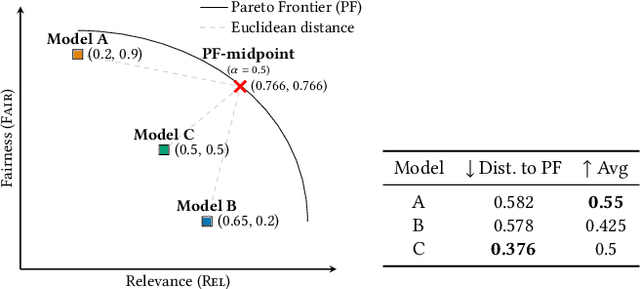

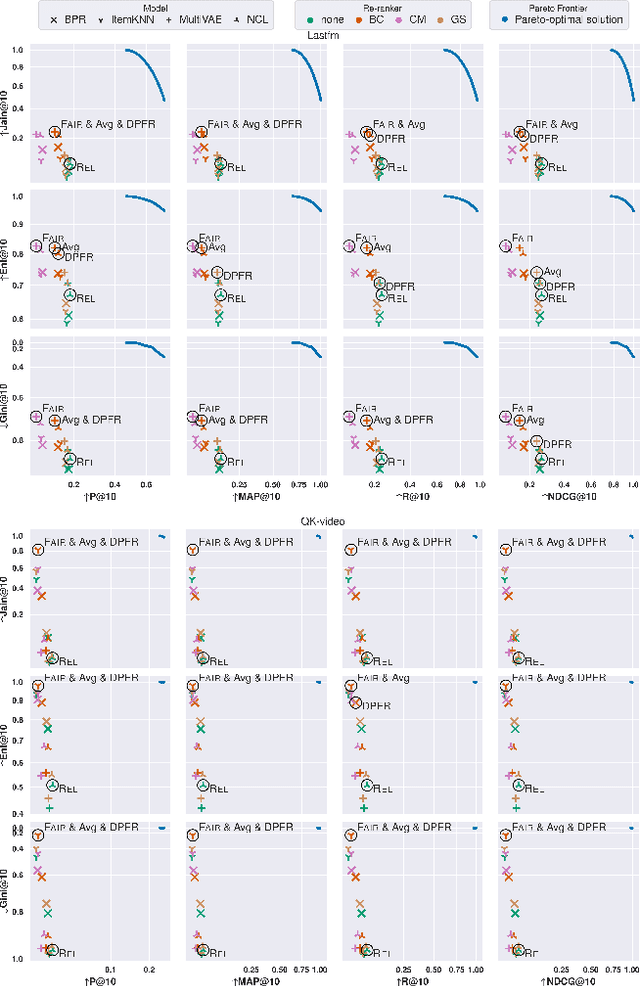
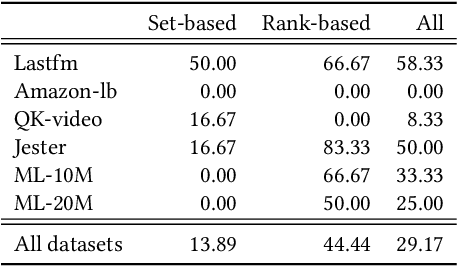
Abstract:Fairness and relevance are two important aspects of recommender systems (RSs). Typically, they are evaluated either (i) separately by individual measures of fairness and relevance, or (ii) jointly using a single measure that accounts for fairness with respect to relevance. However, approach (i) often does not provide a reliable joint estimate of the goodness of the models, as it has two different best models: one for fairness and another for relevance. Approach (ii) is also problematic because these measures tend to be ad-hoc and do not relate well to traditional relevance measures, like NDCG. Motivated by this, we present a new approach for jointly evaluating fairness and relevance in RSs: Distance to Pareto Frontier (DPFR). Given some user-item interaction data, we compute their Pareto frontier for a pair of existing relevance and fairness measures, and then use the distance from the frontier as a measure of the jointly achievable fairness and relevance. Our approach is modular and intuitive as it can be computed with existing measures. Experiments with 4 RS models, 3 re-ranking strategies, and 6 datasets show that existing metrics have inconsistent associations with our Pareto-optimal solution, making DPFR a more robust and theoretically well-founded joint measure for assessing fairness and relevance. Our code: https://github.com/theresiavr/DPFR-recsys-evaluation
Are Representation Disentanglement and Interpretability Linked in Recommendation Models? A Critical Review and Reproducibility Study
Jan 30, 2025



Abstract:Unsupervised learning of disentangled representations has been closely tied to enhancing the representation intepretability of Recommender Systems (RSs). This has been achieved by making the representation of individual features more distinctly separated, so that it is easier to attribute the contribution of features to the model's predictions. However, such advantages in interpretability and feature attribution have mainly been explored qualitatively. Moreover, the effect of disentanglement on the model's recommendation performance has been largely overlooked. In this work, we reproduce the recommendation performance, representation disentanglement and representation interpretability of five well-known recommendation models on four RS datasets. We quantify disentanglement and investigate the link of disentanglement with recommendation effectiveness and representation interpretability. While several existing work in RSs have proposed disentangled representations as a gateway to improved effectiveness and interpretability, our findings show that disentanglement is not necessarily related to effectiveness but is closely related to representation interpretability. Our code and results are publicly available at https://github.com/edervishaj/disentanglement-interpretability-recsys.
A Reality Check on Context Utilisation for Retrieval-Augmented Generation
Dec 22, 2024



Abstract:Retrieval-augmented generation (RAG) helps address the limitations of the parametric knowledge embedded within a language model (LM). However, investigations of how LMs utilise retrieved information of varying complexity in real-world scenarios have been limited to synthetic contexts. We introduce DRUID (Dataset of Retrieved Unreliable, Insufficient and Difficult-to-understand contexts) with real-world queries and contexts manually annotated for stance. The dataset is based on the prototypical task of automated claim verification, for which automated retrieval of real-world evidence is crucial. We compare DRUID to synthetic datasets (CounterFact, ConflictQA) and find that artificial datasets often fail to represent the complex and diverse real-world context settings. We show that synthetic datasets exaggerate context characteristics rare in real retrieved data, which leads to inflated context utilisation results, as measured by our novel ACU score. Moreover, while previous work has mainly focused on singleton context characteristics to explain context utilisation, correlations between singleton context properties and ACU on DRUID are surprisingly small compared to other properties related to context source. Overall, our work underscores the need for real-world aligned context utilisation studies to represent and improve performance in real-world RAG settings.
Joint Extraction and Classification of Danish Competences for Job Matching
Oct 29, 2024Abstract:The matching of competences, such as skills, occupations or knowledges, is a key desiderata for candidates to be fit for jobs. Automatic extraction of competences from CVs and Jobs can greatly promote recruiters' productivity in locating relevant candidates for job vacancies. This work presents the first model that jointly extracts and classifies competence from Danish job postings. Different from existing works on skill extraction and skill classification, our model is trained on a large volume of annotated Danish corpora and is capable of extracting a wide range of Danish competences, including skills, occupations and knowledges of different categories. More importantly, as a single BERT-like architecture for joint extraction and classification, our model is lightweight and efficient at inference. On a real-scenario job matching dataset, our model beats the state-of-the-art models in the overall performance of Danish competence extraction and classification, and saves over 50% time at inference.
From Internal Conflict to Contextual Adaptation of Language Models
Jul 24, 2024



Abstract:Knowledge-intensive language understanding tasks require Language Models (LMs) to integrate relevant context, mitigating their inherent weaknesses, such as incomplete or outdated knowledge. Nevertheless, studies indicate that LMs often ignore the provided context as it can conflict with the pre-existing LM's memory learned during pre-training. Moreover, conflicting knowledge can already be present in the LM's parameters, termed intra-memory conflict. Existing works have studied the two types of knowledge conflicts only in isolation. We conjecture that the (degree of) intra-memory conflicts can in turn affect LM's handling of context-memory conflicts. To study this, we introduce the DYNAMICQA dataset, which includes facts with a temporal dynamic nature where a fact can change with a varying time frequency and disputable dynamic facts, which can change depending on the viewpoint. DYNAMICQA is the first to include real-world knowledge conflicts and provide context to study the link between the different types of knowledge conflicts. With the proposed dataset, we assess the use of uncertainty for measuring the intra-memory conflict and introduce a novel Coherent Persuasion (CP) score to evaluate the context's ability to sway LM's semantic output. Our extensive experiments reveal that static facts, which are unlikely to change, are more easily updated with additional context, relative to temporal and disputable facts.
Can We Trust Recommender System Fairness Evaluation? The Role of Fairness and Relevance
May 28, 2024
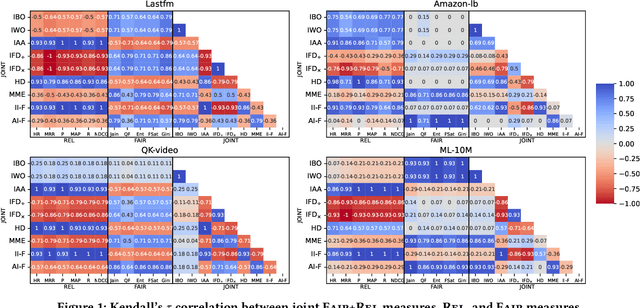

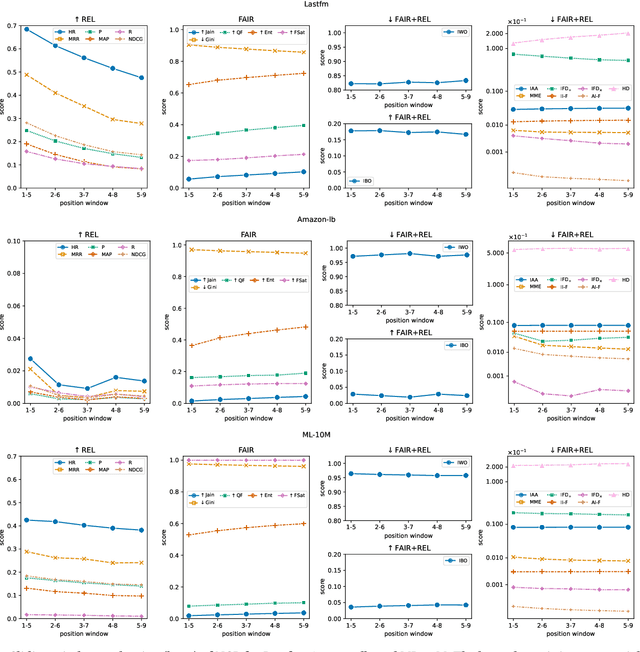
Abstract:Relevance and fairness are two major objectives of recommender systems (RSs). Recent work proposes measures of RS fairness that are either independent from relevance (fairness-only) or conditioned on relevance (joint measures). While fairness-only measures have been studied extensively, we look into whether joint measures can be trusted. We collect all joint evaluation measures of RS relevance and fairness, and ask: How much do they agree with each other? To what extent do they agree with relevance/fairness measures? How sensitive are they to changes in rank position, or to increasingly fair and relevant recommendations? We empirically study for the first time the behaviour of these measures across 4 real-world datasets and 4 recommenders. We find that most of these measures: i) correlate weakly with one another and even contradict each other at times; ii) are less sensitive to rank position changes than relevance- and fairness-only measures, meaning that they are less granular than traditional RS measures; and iii) tend to compress scores at the low end of their range, meaning that they are not very expressive. We counter the above limitations with a set of guidelines on the appropriate usage of such measures, i.e., they should be used with caution due to their tendency to contradict each other and of having a very small empirical range.
Query Augmentation by Decoding Semantics from Brain Signals
Mar 03, 2024



Abstract:Query augmentation is a crucial technique for refining semantically imprecise queries. Traditionally, query augmentation relies on extracting information from initially retrieved, potentially relevant documents. If the quality of the initially retrieved documents is low, then the effectiveness of query augmentation would be limited as well. We propose Brain-Aug, which enhances a query by incorporating semantic information decoded from brain signals. BrainAug generates the continuation of the original query with a prompt constructed with brain signal information and a ranking-oriented inference approach. Experimental results on fMRI (functional magnetic resonance imaging) datasets show that Brain-Aug produces semantically more accurate queries, leading to improved document ranking performance. Such improvement brought by brain signals is particularly notable for ambiguous queries.
Recommending Target Actions Outside Sessions in the Data-poor Insurance Domain
Mar 01, 2024



Abstract:Providing personalized recommendations for insurance products is particularly challenging due to the intrinsic and distinctive features of the insurance domain. First, unlike more traditional domains like retail, movie etc., a large amount of user feedback is not available and the item catalog is smaller. Second, due to the higher complexity of products, the majority of users still prefer to complete their purchases over the phone instead of online. We present different recommender models to address such data scarcity in the insurance domain. We use recurrent neural networks with 3 different types of loss functions and architectures (cross-entropy, censored Weibull, attention). Our models cope with data scarcity by learning from multiple sessions and different types of user actions. Moreover, differently from previous session-based models, our models learn to predict a target action that does not happen within the session. Our models outperform state-of-the-art baselines on a real-world insurance dataset, with ca. 44K users, 16 items, 54K purchases and 117K sessions. Moreover, combining our models with demographic data boosts the performance. Analysis shows that considering multiple sessions and several types of actions are both beneficial for the models, and that our models are not unfair with respect to age, gender and income.
* arXiv admin note: substantial text overlap with arXiv:2211.15360
 Add to Chrome
Add to Chrome Add to Firefox
Add to Firefox Add to Edge
Add to Edge